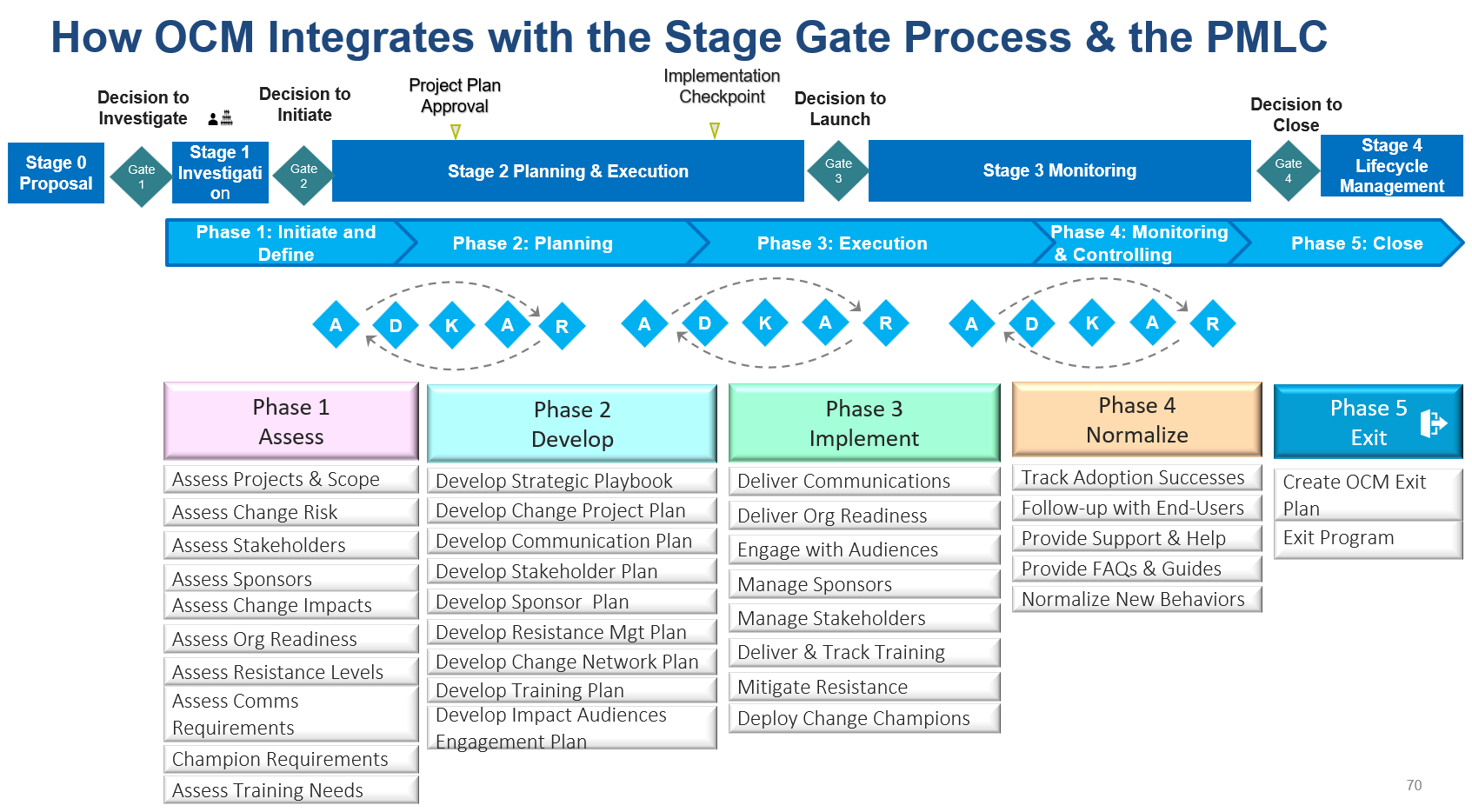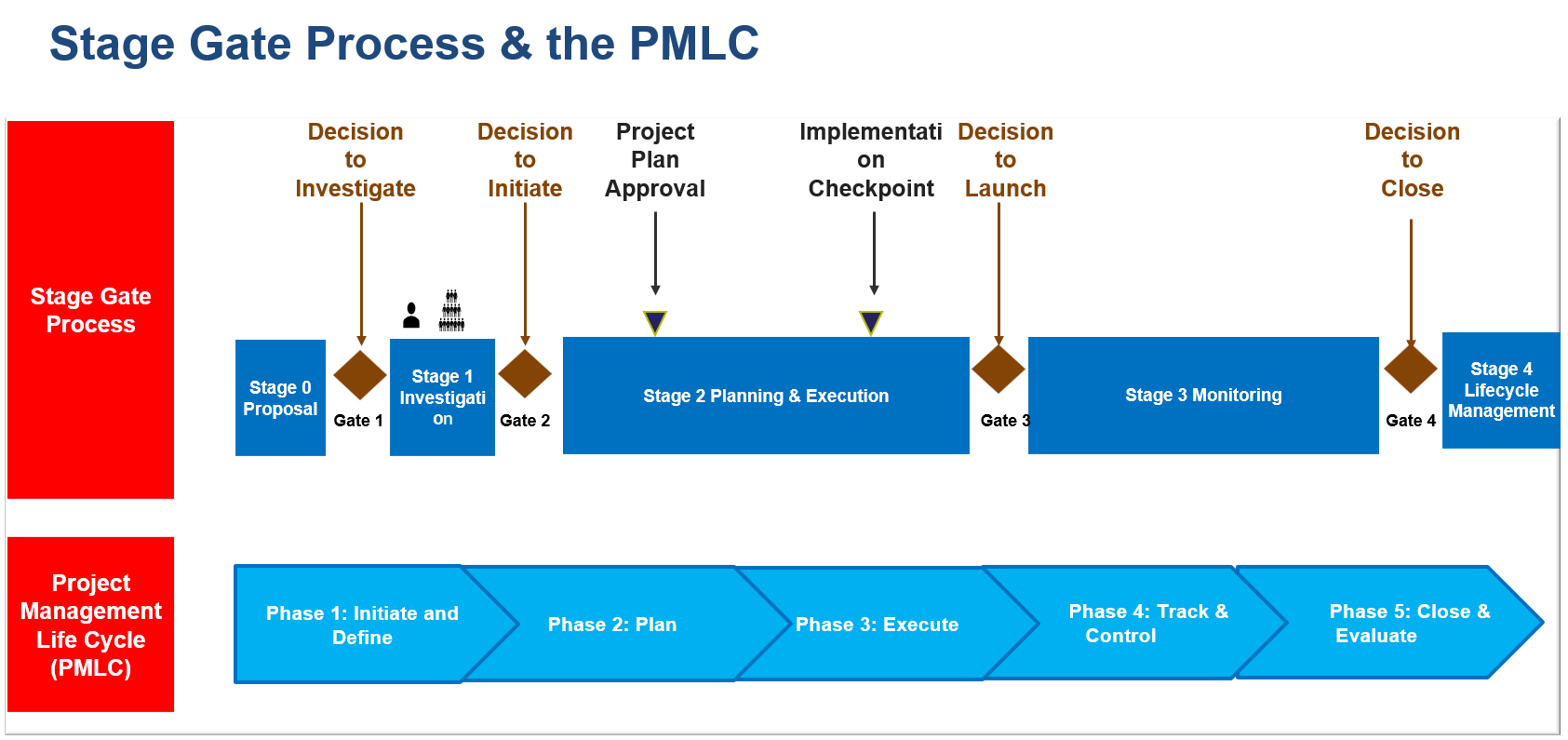Best Practices for Applying Organizational Change Management (OCM) to the Stage Gate Process
Why This Matters: A Story from the Field
Not long ago, I supported a multi-billion-dollar energy firm that was rolling out a new capital project governance framework based on the Stage Gate methodology.
While the technical project team had carefully planned each gate and phase, resistance from engineering and operations leaders stalled early momentum. Their concern? Too much process changes, not enough clarity. That’s where Organizational Change Management (OCM) came in.
By aligning ADKAR-driven OCM activities across each gate and project lifecycle phase, we not only increased stakeholder buy-in but also helped stakeholders and leadership see themselves as key players in the transformation. Adoption rates soared. Project delays dropped. And leaders were equipped to support long-term behavior change.
In this article, I’ll walk you through how to do exactly that seamlessly embed OCM best practices into the Stage Gate process and the Project Management Life Cycle (PMLC) to ensure project success, stakeholder engagement, and long-term impact.
Ogbe Airiodion
Change Management Consultant & Lead
Strategic & Tactical Change Management Implementation

👉 Click here to view the full image
Let’s get started
Watch this overview video about applying OCM with Stage Gate or read the guide below.
Table of Contents
This guide breaks down exactly how OCM supports each stage of the Stage Gate process and offers best practices you can immediately apply.
- Understanding the Stage Gate Framework
- Why Change Management Is Critical for Stage Gate Success
- Best Practices for OCM Integration at Each Gate
- Using ADKAR to Drive Engagement Across Phases
- Real-Life OCM Deliverables That Make a Difference
- Final Thoughts & Key Takeaways
- FAQs
Understanding the Stage Gate Framework
The Stage Gate process breaks down a project into phases separated by “gates”—checkpoints where leadership evaluates progress and decides whether to proceed. It’s a structured method to reduce risk, increase alignment, and support informed go/no-go decisions.
Here’s a simplified breakdown:
- Stage 0: Proposal
- Gate 1: Decision to Investigate
- Stage 1: Investigation
- Gate 2: Decision to Initiate
- Stage 2: Planning & Execution
- Gate 3: Decision to Launch
- Stage 3: Monitoring
- Gate 4: Decision to Close
- Stage 4: Lifecycle Management
The Stage Gate process often aligns with the Project Management Life Cycle (PMLC):
- Phase 1: Initiate and Define
- Phase 2: Plan
- Phase 3: Execute
- Phase 4: Track and Control
- Phase 5: Close and Evaluate

👉 Click here to view the full image
Why Change Management Is Critical for Stage Gate Success
While the Stage Gate process provides clarity and governance, it doesn’t guarantee stakeholder alignment or user adoption. That’s where Organizational Change Management plays a vital role.
When OCM is layered into each phase of the process, it helps:
- Reduce resistance
- Ensure leadership sponsorship
- Support communication and engagement
- Align project goals with user needs
- Normalize new ways of working
Without effective OCM, a well-structured Stage Gate process risks becoming a bureaucratic exercise instead of a business enabler.
Best Practices for OCM Integration at Each Gate of the State Page Project Method
OCM doesn’t just belong at the end of a project—it should be infused from the beginning. Here’s how to align it with each gate and phase:
Gate 1: Decision to Investigate
OCM Focus: Assess readiness
- Analyze stakeholder landscape
- Evaluate change risks and impacts
- Identify change champions
- Begin communication planning
Gate 2: Decision to Initiate
OCM Focus: Build the change strategy
- Develop the Change Management Plan
- Define sponsor and stakeholder roles
- Begin resistance management planning
- Craft messaging and engagement tools
Stage 2: Planning & Execution
OCM Focus: Develop and deploy
- Finalize training, comms, and readiness plans
- Align with project milestones
- Deliver pre-launch engagement sessions
- Track feedback loops
Gate 3: Decision to Launch
OCM Focus: Support activation
- Reinforce leadership messages
- Launch user readiness campaigns
- Deploy training
- Initiate change champion activation
Stage 3: Monitoring
OCM Focus: Normalize and sustain
- Monitor adoption
- Address resistance and feedback
- Provide ongoing support
- Embed changes into performance metrics
Gate 4: Decision to Close
OCM Focus: Evaluate and exit
- Document lessons learned
- Plan knowledge transfer
- Develop an OCM exit plan
- Celebrate success and reinforce wins

Using ADKAR to Drive Engagement Across Phases
The ADKAR model (Awareness, Desire, Knowledge, Ability, Reinforcement) integrates beautifully into the Stage Gate model.
Here’s how to apply ADKAR across the lifecycle:
- Awareness: Build early through targeted messaging in Stage 0 and Stage 1
- Desire: Use champions and leadership to inspire buy-in before Gate 2
- Knowledge: Deliver training and readiness in Stage 2
- Ability: Provide just-in-time support and coaching as execution begins
- Reinforcement: Normalize behaviors during Stage 3 and embed changes into routines in Stage 4
Real-Life OCM Deliverables That Make a Difference
Across each OCM phase, there are key deliverables that ensure alignment and adoption. Here’s a breakdown based on the second image shared:
Phase 1: Assess
- Change risk assessments
- Stakeholder mapping
- Organizational readiness survey
- Communication and training needs analysis
Phase 2: Develop
- Change playbook
- Communication and training plans
- Sponsor roadmap
- Engagement and resistance strategies
Phase 3: Implement
- Deployment of comms and training
- Champion network activation
- Resistance mitigation playbooks
- Engagement metrics
Phase 4: Normalize
- Adoption monitoring dashboard
- End-user support model
- Reinforcement and rewards
- Behavior normalization plans
Phase 5: Exit
- OCM Exit Plan
- Final review and stakeholder debrief
- Transition support for lifecycle ownership
Final Thoughts & Key Takeaways
A Stage Gate project without OCM is like a well-built ship with no crew to guide it. By integrating OCM best practices into each gate, you ensure that the process is more than just paperwork—it becomes a journey of adoption, alignment, and transformation.
OCM turns process milestones into engagement opportunities—maximizing success and minimizing resistance every step of the way.
Pro Tips
Pro Tip 1: Align your OCM deliverables directly with project gate reviews. This ensures leadership sees the change strategy as an essential success factor, not a side activity.
Pro Tip 2: Use change champions not just to communicate—but to listen. Their feedback can surface hidden resistance and improve execution quality across all stages.
OCM ensures stakeholder alignment, manages resistance, and drives adoption across each gate and phase—transforming procedural steps into people-centered milestones.
Yes. The ADKAR model overlays naturally with each stage, guiding your communications, training, and support strategies to meet people where they are.
As early as Stage 0. The earlier you involve OCM, the more effective your change strategy will be across the lifecycle.
Waiting too long. Many teams wait until Stage 3 to engage OCM, missing crucial early buy-in and momentum.
Typically, a Change Management Lead, supported by project sponsors, business stakeholders, and change champions embedded across the organization.What is the role of OCM in the Stage Gate process?
Can I apply ADKAR in parallel with the Stage Gate process?
At what point should I involve OCM?
What’s the biggest OCM mistake in Stage Gate projects?
Who should own the OCM workstream in a Stage Gate program?
Note: Content on OCM Solution's ocmsolution.com website is protected by copyright. Should you have any questions or comments regarding this OCM Solutions page, please reach out to Ogbe Airiodion (Change Management Lead) or the OCM Solutions Team today.



